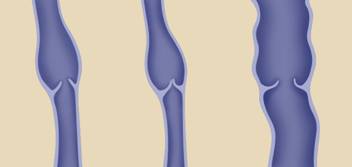Articles
Suffering is optional for Women with Venus Reflux Disease
Pravin M. Shah, MD, FACS*
Westchester Laser Vein Center
Do your legs ache or feel heavy especially during the second half of your menstrual cycle? Are you embarrassed to wear a bathing suit or show your legs in public because of unsightly veins on your legs? If the answer is yes then most likely you may be suffering with venous reflux disease.
Venous reflux disease is a disease of a venous system in the leg, which result in venous congestion and varicose veins. It is estimated that two thirds of adult women have physically identifiable varicosities and one in five women have severe venous insufficiency.
Blood is pumped by the heart and circulated throughout the body via arteries. The arteries ultimately end in tiny pipes called capillaries. After delivering oxygen to the tissue and carrying back metabolic waste, blood return to the heart by a series of pipes called veins. We have two venous systems in the legs, a superficial venous system and a deep venous system. The superficial venous system is what we see often under our skin. Two main superficial veins in the legs are a grater and a lesser saphenous vein. The deep venous system, as name applies, is hidden deep under the muscles.
Heart |
Normal vein |
Dilated vein |
|
 |
|||
Legs |
Open Valve |
Closed valve |
Leaky Valve |
Illustration courtesy of VNUS medical technologies
When we walk, a pumping action of the calf muscle facilitates an upward movement of the blood in the vein. One-way valves at the multiple levels in the vein facilitate movement of the blood against gravity. Blood normally travels from the superficial system to the deep system in the leg. One of the most important valves in the vein, near the groin, is called saphno-femoral valve. This valve is at the junction between greater saphenous vein (superficial vein) and femoral vein (deep vein) and prevents blood going to the superficial system from the deep system. When valves in the vein are defective, the blood leaks (venous reflux) and instead of moving upward towards the heart pools down in the leg causing venous stasis (venostasis) or venous congestion. Over the course of time vein and its branches (tributaries) in the leg enlarges to become prominent bulge and ultimately awful looking varicose veins. When a vein abnormally dilates, its valves become incompetent and create a vicious circle. Hormonal changes during the menstrual cycle aggravate the situation.
The symptoms of venous congestion and venous reflux vary from mild discomfort to ugly looking veins, severe pigmentation and ulceration of skin. It is unfortunate that many women suffer silently from symptoms of venous reflux disease. The dull aching pain, heaviness, fatigue (especially at the end of the day) relieved by elevation of legs, is accepted as normal. On the other hand many young women go through the life feeling self-conscious and are embarrassed to go to the beach or attend pool party because of the presence of unattractive veins on the legs.
Diagnosis of venous reflux disease is easily made by a physician on clinical examination and confirmed by a non-invasive ultrasound examination.
Once the diagnosis is made the treatment can be as simple as wearing medical grade support stockings. Today many companies make a sheer quality attractive support stocking with different skin tones. Proper use of support stockings and exercise to promote venous return to the heart relieves congestion in the legs and symptoms related to venous pooling. In addition this simple step would prevent or delay in forming bulging of the veins that ultimately may become varicose veins.
In many complex cases where the reflux is severe enough to cause significant varicosities in the leg, there used to be a surgical procedure called ligation and stripping of the greater saphenous vein. The procedure is performed under general or spinal anesthesia and associated with significant pain in the postoperative period. Many women are understandably afraid to undergo this surgical procedure.
Today modern technology allow us to use alternative minimally invasive procedure called vein closer (Vnus Closer) instead of traditional ligation and stripping. The procedure involves inserting a catheter into the damaged vein through a small incision. The catheter delivers radio frequency energy to the vein wall to shrink and seal it shut. Most patients are much pleased with this procedure because not only it is almost pain free but it also allows them to resume normal activity immediately after the treatment.
Once the reflux is taken care, unattractive spider veins or small varicose veins can effectively and safely be treated by minimally invasive simple procedures like laser treatment, sclerotherapy, vein Gogh or mini phelbectomy with good result. The Laser treatment is generally used for treating spider veins. Laser energy is applied to small veins by a probe on the skin, this causes the vessel walls to coagulate and the spider veins disappear. Sclerotherapy is a method in which sclerosing solution is injected directly in the vein by a tiny needle. The solution causes the vein wall to become sticky. Compression is then applied which causes it to close up and eventually be absorbed by the body. Miniphlebectomy is a procedure used to treat localized larger veins. Tiny punctures are made over the skin numbed by an anesthetic solution. A varicose vein is removed using a special hook. Incisions are small and usually do not require stitches.
Thus use of support stockings, exercise and proper selection of minimally invasive procedure, if needed, relives the suffering from venous reflux disease. Over all quality of life is certainly improves with pain free and good looking legs.
.
Pravin Shah, MD FACS, RVT
* Professor of Surgery
New York Medical
Co-founder of Westchester Laser Vein Center
4/28/2011
